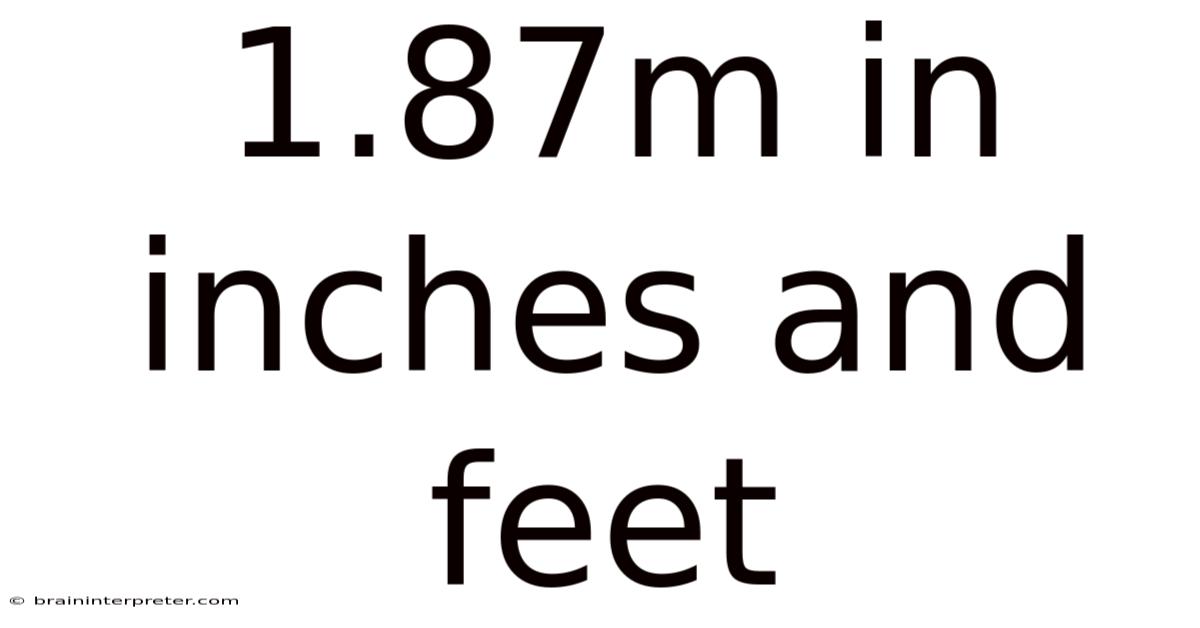1.87m In Inches And Feet
braininterpreter
Sep 20, 2025 · 4 min read

Table of Contents
1.87m in Inches and Feet: A Comprehensive Guide to Metric-Imperial Conversions
Are you struggling to visualize 1.87 meters? Do you need to convert this metric measurement into the more familiar imperial units of inches and feet? This comprehensive guide will not only provide you with the precise conversions but also delve into the underlying principles of metric-imperial conversions, explore practical applications, and address frequently asked questions. Understanding these conversions is crucial for various fields, from construction and engineering to everyday life. Let's dive in!
Introduction: Understanding the Metric and Imperial Systems
Before we jump into the conversion of 1.87 meters, let's briefly review the two systems of measurement:
-
Metric System (International System of Units or SI): This system, based on powers of 10, is used globally by scientists and most countries. Its fundamental units include the meter (length), kilogram (mass), and second (time). Its simplicity and ease of conversion make it highly efficient.
-
Imperial System (US Customary Units): Predominantly used in the United States, this system uses units like inches, feet, yards, and miles for length. It lacks the elegant simplicity of the metric system, making conversions more complex.
Understanding the fundamental difference between these systems is crucial for accurate conversions. The metric system's decimal-based nature makes calculations straightforward, while the imperial system requires memorizing various conversion factors.
Converting 1.87 Meters to Inches
To convert 1.87 meters to inches, we need to know the conversion factor: 1 meter = 39.3701 inches.
Therefore, the calculation is:
1.87 meters * 39.3701 inches/meter = 73.622 inches (approximately)
This means that 1.87 meters is roughly equivalent to 73.622 inches.
Converting 1.87 Meters to Feet
Now, let's convert 1.87 meters to feet. We know that 1 foot = 12 inches and 1 meter = 39.3701 inches. We can use these conversion factors in a two-step process:
-
Convert meters to inches: As calculated above, 1.87 meters equals 73.622 inches.
-
Convert inches to feet: Divide the number of inches by 12: 73.622 inches / 12 inches/foot = 6.135 feet (approximately)
So, 1.87 meters is approximately equal to 6.135 feet.
Understanding the Conversion Process: A Deeper Dive
The conversions above utilized simple multiplication and division. However, let's explore the rationale behind these calculations to enhance our understanding:
The conversion factor between meters and inches (39.3701) is derived from the fundamental relationship between the meter and the inch. Historically, the inch was defined differently in various countries, leading to slight variations in the conversion factor. However, the modern definition of the inch, based on the meter, provides a consistent and accurate conversion.
When converting from a larger unit (meters) to a smaller unit (inches), we multiply by the conversion factor. Conversely, when converting from a smaller unit (inches) to a larger unit (feet), we divide by the conversion factor. This principle applies to all unit conversions, regardless of the system involved.
Practical Applications of Metric-Imperial Conversions
The ability to accurately convert between metric and imperial units is valuable across numerous fields:
-
Construction and Engineering: Projects often involve blueprints or specifications using different measurement systems. Accurate conversions are crucial for ensuring precise measurements and avoiding costly errors.
-
Manufacturing and Production: Global manufacturing often involves components sourced from different regions using different measurement systems. Precise conversions ensure compatibility and prevent production delays.
-
Healthcare: Medical devices and pharmaceuticals may have specifications in both metric and imperial units. Accurate conversions are critical for correct dosage and device operation.
-
Everyday Life: While many countries primarily use the metric system, encountering imperial units in various contexts is common. Being able to convert between the systems helps in understanding sizes, distances, and weights.
Frequently Asked Questions (FAQs)
Q: Why are there two different systems of measurement?
A: The imperial system evolved organically over centuries, lacking a unified and systematic approach. The metric system, developed later, aimed for a rational and consistent system based on powers of 10, making it easier to use and understand.
Q: Which system is more accurate?
A: Both systems are capable of high accuracy. The difference lies in the simplicity and consistency of the metric system, which reduces errors in calculations and conversions.
Q: Are there online converters for metric-imperial conversions?
A: Yes, many online converters are readily available. These tools can perform various conversions quickly and accurately. However, understanding the underlying principles is essential for independent verification and problem-solving.
Q: What are some common conversion errors to avoid?
A: Common errors include using the wrong conversion factor, forgetting to multiply or divide correctly, and misinterpreting unit symbols. Always double-check your calculations and units to avoid mistakes.
Conclusion: Mastering Metric-Imperial Conversions
Mastering the conversion between metric and imperial units is a valuable skill with widespread applications. While online converters are helpful tools, understanding the underlying principles is crucial for accurate conversions and problem-solving. By grasping the conversion factors and the logic behind the calculations, you can confidently navigate various scenarios requiring metric-imperial conversions, whether it's determining the height of a person (like our 1.87 meters example), building a structure, or understanding product specifications. Remember, accuracy is paramount, so always double-check your work and utilize the appropriate conversion factors to ensure precision. The ability to confidently convert between these systems demonstrates a strong grasp of fundamental measurement principles and enhances your problem-solving skills across multiple disciplines.
Latest Posts
Latest Posts
-
Convert 60 Mm To Inches
Sep 20, 2025
-
100cm Equals How Many Inches
Sep 20, 2025
-
How Much Is 14 Kilograms
Sep 20, 2025
-
56 Cm Converted To Inches
Sep 20, 2025
-
70 Meters How Many Feet
Sep 20, 2025
Related Post
Thank you for visiting our website which covers about 1.87m In Inches And Feet . We hope the information provided has been useful to you. Feel free to contact us if you have any questions or need further assistance. See you next time and don't miss to bookmark.